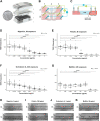A high-throughput gut-on-chip platform to study the epithelial responses to enterotoxins
- PMID: 38461178
- PMCID: PMC10925042
- DOI: 10.1038/s41598-024-56520-5
A high-throughput gut-on-chip platform to study the epithelial responses to enterotoxins
Abstract
Enterotoxins are a type of toxins that primarily affect the intestines. Understanding their harmful effects is essential for food safety and medical research. Current methods lack high-throughput, robust, and translatable models capable of characterizing toxin-specific epithelial damage. Pressing concerns regarding enterotoxin contamination of foods and emerging interest in clinical applications of enterotoxins emphasize the need for new platforms. Here, we demonstrate how Caco-2 tubules can be used to study the effect of enterotoxins on the human intestinal epithelium, reflecting toxins' distinct pathogenic mechanisms. After exposure of the model to toxins nigericin, ochratoxin A, patulin and melittin, we observed dose-dependent reductions in barrier permeability as measured by TEER, which were detected with higher sensitivity than previous studies using conventional models. Combination of LDH release assays and DRAQ7 staining allowed comprehensive evaluation of toxin cytotoxicity, which was only observed after exposure to melittin and ochratoxin A. Furthermore, the study of actin cytoskeleton allowed to assess toxin-induced changes in cell morphology, which were only caused by nigericin. Altogether, our study highlights the potential of our Caco-2 tubular model in becoming a multi-parametric and high-throughput tool to bridge the gap between current enterotoxin research and translatable in vivo models of the human intestinal epithelium.
© 2024. The Author(s).
Conflict of interest statement
M.M., M.C.R., and K.Q. are employees of Mimetas B.V., which markets OrganoPlate, OrganoTEER, and OrganoFlow, and holds the registered trademarks OrganoPlate, OrganoTEER, and OrganoFlow.
Figures





Similar articles
-
Clostridioides difficile toxin A-mediated Caco-2 cell barrier damage was attenuated by insect-derived fractions and corresponded to increased gene transcription of cell junctional and proliferation proteins.Food Funct. 2021 Oct 4;12(19):9248-9260. doi: 10.1039/d1fo00673h. Food Funct. 2021. PMID: 34606540
-
Staphylococcal enterotoxins fail to disrupt membrane integrity or synthetic functions of Henle 407 intestinal cells.Infect Immun. 1981 Mar;31(3):929-34. doi: 10.1128/iai.31.3.929-934.1981. Infect Immun. 1981. PMID: 7228407 Free PMC article.
-
Clostridium difficile toxin B is an inflammatory enterotoxin in human intestine.Gastroenterology. 2003 Aug;125(2):413-20. doi: 10.1016/s0016-5085(03)00902-8. Gastroenterology. 2003. PMID: 12891543
-
Enterotoxins and the enteric nervous system--a fatal attraction.Int J Med Microbiol. 2000 Oct;290(4-5):491-6. doi: 10.1016/S1438-4221(00)80073-9. Int J Med Microbiol. 2000. PMID: 11111932 Review.
-
Impact of the Escherichia coli Heat-Stable Enterotoxin b (STb) on Gut Health and Function.Toxins (Basel). 2020 Dec 2;12(12):760. doi: 10.3390/toxins12120760. Toxins (Basel). 2020. PMID: 33276476 Free PMC article. Review.
Cited by
-
Flow-induced mechano-modulation of intestinal permeability on chip.Mater Today Bio. 2025 Jun 6;33:101951. doi: 10.1016/j.mtbio.2025.101951. eCollection 2025 Aug. Mater Today Bio. 2025. PMID: 40547488 Free PMC article.
-
Establishment and evaluation of on-chip intestinal barrier biosystems based on microfluidic techniques.Mater Today Bio. 2024 May 5;26:101079. doi: 10.1016/j.mtbio.2024.101079. eCollection 2024 Jun. Mater Today Bio. 2024. PMID: 38774450 Free PMC article. Review.
-
Breaking Barriers: Candidalysin Disrupts Epithelial Integrity and Induces Inflammation in a Gut-on-Chip Model.Toxins (Basel). 2025 Feb 14;17(2):89. doi: 10.3390/toxins17020089. Toxins (Basel). 2025. PMID: 39998106 Free PMC article.
-
Changes in Generations of PAMAM Dendrimers and Compositions of Nucleic Acid Nanoparticles Govern Delivery and Immune Recognition.ACS Biomater Sci Eng. 2025 Jun 9;11(6):3726-3737. doi: 10.1021/acsbiomaterials.5c00336. Epub 2025 May 20. ACS Biomater Sci Eng. 2025. PMID: 40391736 Free PMC article.
-
Advancing diagnostics and disease modeling: current concepts in biofabrication of soft microfluidic systems.In Vitro Model. 2024 Jun 4;3(2-3):139-150. doi: 10.1007/s44164-024-00072-5. eCollection 2024 Jun. In Vitro Model. 2024. PMID: 39872940 Free PMC article.
References
MeSH terms
Substances
Grants and funding
LinkOut - more resources
Full Text Sources
Miscellaneous

